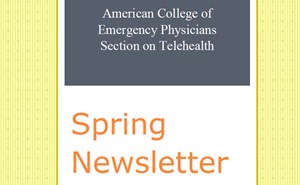
Five Awesome Abstracts
“In God we trust. All others must bring data.” – W. Edwards Deming
***If there are abstracts you have found to be great, please send them to the Newsletter Editor for consideration for the next issue!***
Abiri, A., et al. (2022). "The Impact of Virtual Care in an Emergency Department Observation Unit." Ann Emerg Med.
STUDY OBJECTIVE(S): We report the impact of telemedicine virtual rounding in emergency department observation units (EDOU) on the effectiveness, safety, and cost relative to traditional observation care. METHODS: In this retrospective diff-in-diff study, we compared observation visit outcomes from 2 EDOUs before (pre) and after (post) full adoption of telemedicine rounding tele-observation (tele-obs) with usual care in control EDOU and care in a hospital bed in an integrated health system without tele-obs. Tele-obs physicians did not work at the control hospital. Outcomes were the length of stay, total direct costs, admission status, and adverse events (ICU and death). Difference-in-differences modeling evaluated outcomes with covariates including age, sex, payer type, and clinical classification software diagnostic category. Data from a system data warehouse and a cost accounting database were used. RESULTS: Of the 20,861 EDOU visits, 15,630 (74.9%) were seen in the preperiod and 6,657 (31.9%) in control EDOU. Of 23,055 non-EDOU inpatient visits assigned to observation status (nonobservation unit), 76% were seen in the preperiod. Adjusted length of stay was not significantly different for tele-obs and control EDOUs (26.4 hours versus 23.5 hours), which remained lower than in hospital settings (37.9 hours). The pre-post diff-in-diff was not significant (P=.78). Inpatient admission status was similar for tele-obs and control EDOUs (20.9% versus 22.4.%) and lower than in hospital settings (30.3%). Prepost odds ratios for inpatient admission and adverse outcomes did not change significantly for all study groups. Adjusted costs increased over time for all settings; however, the prepost median cost change was not significantly different between tele-obs EDOUs and control EDOUs ($162.5 versus $235) and was lower than the change for control hospital settings ($783). Median tele-obs EDOU cost over both periods ($1,541) remained significantly lower than hospital costs ($2,413). CONCLUSION: Using tele-obs to manage observation patients in an ED observation unit was not associated with significant differences in length of stay, admission status, measured adverse events, or total direct cost.
Khoong, E. C. (2022). "Policy Considerations To Ensure Telemedicine Equity." Health Aff (Millwood) 41(5): 643-646.
Telemedicine use has exploded during the past two years, but it has done so without sufficient attention to disparities by payer, age, race and ethnicity, income, English language proficiency, and geography. The process of designing permanent, postpandemic telehealth policies must center on equity. Current conversations on equity have focused on broadband access and payment parity between telemedicine modalities (audio only and audiovisual) and in-person care. However, creating telehealth policies that ensure equity will require a more comprehensive, cautious approach that acknowledges the unknowns about how to implement telemedicine to improve health, addresses the multilevel barriers to equity, and reconsiders the purpose and value of telemedicine.
Friedman, J., et al. (2021). "Telemedicine Medical Screening Evaluation Expedites the Initiation of Emergency Care for Children." Pediatr Emerg Care 37(7): e417-e420.
OBJECTIVE: Prior studies show that staffing a physician at triage expedites care in the emergency department. Our objective was to describe the novel application and effect of a telemedicine medical screening evaluation (Tele-MSE) at triage on quality metrics in the pediatric emergency department (PED). METHODS: We conducted a retrospective quasi-experimental pre-post intervention study of patients presenting to an urban PED from December 2017 to November 2019 who received a Tele-MSE at triage. We analyzed 4 diagnostic cohorts: gastroenteritis, psychiatry evaluation, burn injury, and extremity fracture. We matched cases with controls who received standard triage, from December 2015 to November 2017, by age, diagnosis, weekday versus weekend, and season of presentation. Outcome measures included door-to-provider time, time-to-intervention order, and PED length of stay (LOS). RESULTS: We included 557 patients who received Tele-MSE during the study period. Compared with controls, patients who received a Tele-MSE at triage had a shorter median door-to-provider time (median difference [MD], 8.4 minutes; 95% confidence interval [CI], 6.0-11.0), time-to-medication order (MD, 27.3 minutes; 95% CI, 22.9-35.2), time-to-consult order (MD, 10.0 minutes; 95% CI, 5.3-12.7), and PED LOS (MD, 0.4 hours; 95% CI, 0.3-0.6). CONCLUSIONS: A Tele-MSE is an innovative modality to expedite the initiation of emergency care and reduce PED LOS for children. This novel intervention offers potential opportunities to optimize provider and patient satisfaction and safety during the COVID-19 pandemic.
Roberge, J., et al. (2020). "Effect of a Virtual Patient Navigation Program on Behavioral Health Admissions in the Emergency Department: A Randomized Clinical Trial." JAMA Netw Open 3(1): e1919954.
IMPORTANCE: The number of patients presenting to emergency departments (EDs) for psychiatric care continues to increase. Psychiatrists often make a conservative recommendation to admit patients because robust outpatient services for close follow-up are lacking. OBJECTIVE: To assess whether the availability of a 45-day behavioral health-virtual patient navigation program decreases hospitalization among patients presenting to the ED with a behavioral health crisis or need. DESIGN, SETTING, AND PARTICIPANTS: This randomized clinical trial enrolled 637 patients who presented to 6 EDs spanning urban and suburban locations within a large integrated health care system in North Carolina from June 12, 2017, through February 14, 2018; patients were followed up for up to 45 days. Eligible patients were aged 18 years or older, with a behavioral health crisis and a completed telepsychiatric ED consultation. The availability of the behavioral health-virtual patient navigation intervention was randomly allocated to specific days (Monday through Friday from 7 am to 7 pm) so that, in a 2-week block, there were 5 intervention days and 5 usual care days; 323 patients presented on days when the program was offered, and 314 presented on usual care days. Data analysis was performed from March 7 through June 13, 2018, using an intention-to-treat approach. INTERVENTIONS: The behavioral health-virtual patient navigation program included video contact with a patient while in the ED and telephonic outreach 24 to 72 hours after discharge and then at least weekly for up to 45 days. MAIN OUTCOMES AND MEASURES: The primary outcome was the conversion of an ED encounter to hospital admission. Secondary outcomes included 45-day follow-up encounters with a self-harm diagnosis and postdischarge acute care use. RESULTS: Among 637 participants, 358 (56.2%) were men, and the mean (SD) age was 39.7 (16.6) years. The conversion rates were 55.1% (178 of 323) in the intervention group vs 63.1% (198 of 314) in the usual care group (odds ratio, 0.74; 95% CI, 0.54-1.02; P = .06). The percentage of patient encounters with follow-up encounters having a self-harm diagnosis was significantly lower in the intervention group compared with the usual care group (36.8% [119 of 323] vs 45.5% [143 of 314]; P = .03). CONCLUSIONS AND RELEVANCE: Although the primary result did not reach statistical significance, there is a strong signal of potential positive benefit in an area that lacks evidence, suggesting that there should be additional investment and inquiry into virtual behavioral health programs. TRIAL REGISTRATION: ClinicalTrials.gov identifier: NCT03204643.
Joseph, J. W., et al. (2020). "Reducing Emergency Department Transfers from Skilled Nursing Facilities Through an Emergency Physician Telemedicine Service." West J Emerg Med 21(6): 205-209.
INTRODUCTION: Transfers of skilled nursing facility (SNF) residents to emergency departments (ED) are linked to morbidity, mortality and significant cost, especially when transfers result in hospital admissions. This study investigated an alternative approach for emergency care delivery comprised of SNF-based telemedicine services provided by emergency physicians (EP). We compared this on-site emergency care option to traditional ED-based care, evaluating hospital admission rates following care by an EP. METHODS: We conducted a retrospective, observational study of SNF residents who underwent emergency evaluation between January 1, 2017-January 1, 2018. The intervention group was comprised of residents at six urban SNFs in the Northeastern United States, who received an on-demand telemedicine service provided by an EP. The comparison group consisted of residents of SNFs that did not offer on-demand services and were transferred via ambulance to the ED. Using electronic health record data from both the telemedicine and ambulance transfers, our primary outcome was the odds ratio (OR) of a hospital admission. We also conducted a subanalysis examining the same OR for the three most common chronic disease-related presentations found among the telemedicine study population. RESULTS: A total of 4,606 patients were evaluated in both the SNF-based intervention and ED-based comparison groups (n=2,311 for SNF based group and 2,295 controls). Patients who received the SNF-based acute care were less likely to be admitted to the hospital compared to patients who were transferred to the ED in our primary and subgroup analyses. Overall, only 27% of the intervention group was transported to the ED for additional care and presumed admission, whereas 71% of the comparison group was admitted (OR for admission = 0.15 [9% confidence interval, 0.13-0.17]). CONCLUSION: The use of an EP-staffed telemedicine service provided to SNF residents was associated with a significantly lower rate of hospital admissions compared to the usual ED-based care for a similarly aged population of SNF residents. Providing SNF-based care by EPs could decrease costs associated with hospital-based care and risks associated with hospitalization, including cognitive and functional decline, nosocomial infections, and falls.



